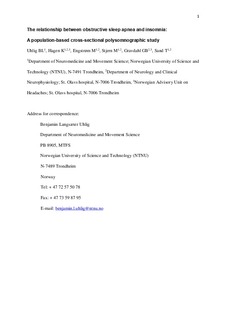| dc.contributor.author | Uhlig, Benjamin Langsæter | |
| dc.contributor.author | Hagen, Knut | |
| dc.contributor.author | Engstrøm, Morten | |
| dc.contributor.author | Stjern, Marit | |
| dc.contributor.author | Gravdahl, Gøril Bruvik | |
| dc.contributor.author | Sand, Trond | |
| dc.date.accessioned | 2019-06-14T07:15:47Z | |
| dc.date.available | 2019-06-14T07:15:47Z | |
| dc.date.created | 2018-12-17T14:44:23Z | |
| dc.date.issued | 2018 | |
| dc.identifier.citation | Sleep Medicine. 2018, 54 126e-133. | nb_NO |
| dc.identifier.issn | 1389-9457 | |
| dc.identifier.uri | http://hdl.handle.net/11250/2600798 | |
| dc.description.abstract | Background
The relationship between insomnia and objectively measured obstructive sleep apnea (OSA) severity has not previously been investigated in both genders in the general population. The main aim of this population-based polysomnography (PSG) study was to evaluate the cross-sectional association between severity of OSA and DSM-V insomnia and insomnia severity.
Methods
A random sample of 1200 participants in the third Nord-Trøndelag Health Study (HUNT3) was invited and 213 (18%) aged between 21 and 82 years underwent an ambulatory PSG, a semi-structured interview, and a sleep-specific questionnaire. A proxy DSM-V insomnia diagnosis as well as an Insomnia Symptom Score (ISS, range 0–12) were calculated from three insomnia questions and one daytime sleepiness symptom question. Participants were then divided into three groups according to their apnea-hypopnea index (AHI): AHI < 5 (without OSA), AHI 5–14.9 (mild OSA), and AHI ≥ 15 (moderate-to-severe OSA). Associations between prevalence of insomnia and OSA groups were assessed by logistic regression models adjusted for age and gender. Associations between ISS and OSA were assessed in a general linear model with contrasts.
Results
A total of 25.2% (29.1% women, 12.5% men) had insomnia. Insomnia prevalence did not differ between subjects with and without OSA, but ISS differed significantly between OSA categories (ANCOVA df 2, F = 6.73, p = 0.001). ISS was lower in the moderate-to-severe OSA-group compared to those without OSA (mean difference −2.68; 95% [CI −4.33, −1.04]; p = 0.002). In subjects with moderate-to-severe OSA, ISS correlated negatively with age (Pearson r = −0.66, p = 0.015).
Conclusion
In this population-based PSG study, no overall statistical association between OSA and insomnia prevalence was found. However, participants with moderate-to-severe OSA reported less insomnia symptoms than subjects without OSA, in particular in older individuals. | nb_NO |
| dc.language.iso | eng | nb_NO |
| dc.publisher | Elsevier | nb_NO |
| dc.rights | Attribution-NonCommercial-NoDerivatives 4.0 Internasjonal | * |
| dc.rights.uri | http://creativecommons.org/licenses/by-nc-nd/4.0/deed.no | * |
| dc.title | The relationship between obstructive sleep apnea and insomnia: a population-based cross-sectional polysomnographic study. | nb_NO |
| dc.type | Journal article | nb_NO |
| dc.type | Peer reviewed | nb_NO |
| dc.description.version | acceptedVersion | nb_NO |
| dc.source.pagenumber | 126e-133 | nb_NO |
| dc.source.volume | 54 | nb_NO |
| dc.source.journal | Sleep Medicine | nb_NO |
| dc.identifier.doi | 10.1016/j.sleep.2018.10.026 | |
| dc.identifier.cristin | 1644332 | |
| dc.description.localcode | © 2018. This is the authors’ accepted and refereed manuscript to the article. Locked until 17 November 2019 due to copyright restrictions. This manuscript version is made available under the CC-BY-NC-ND 4.0 license http://creativecommons.org/licenses/by-nc-nd/4.0/ | nb_NO |
| cristin.unitcode | 194,65,30,0 | |
| cristin.unitname | Institutt for nevromedisin og bevegelsesvitenskap | |
| cristin.ispublished | true | |
| cristin.fulltext | postprint | |
| cristin.qualitycode | 1 | |

